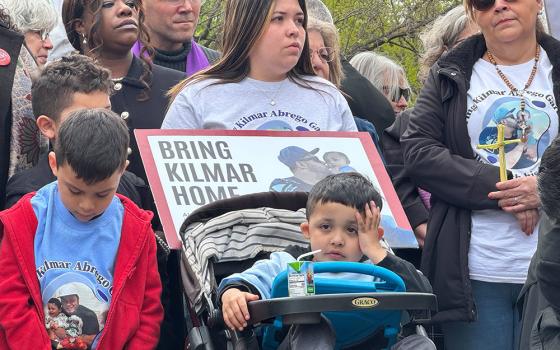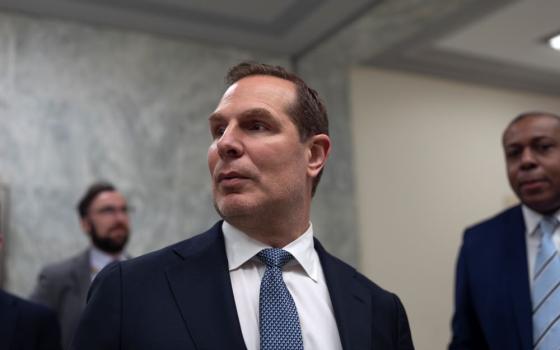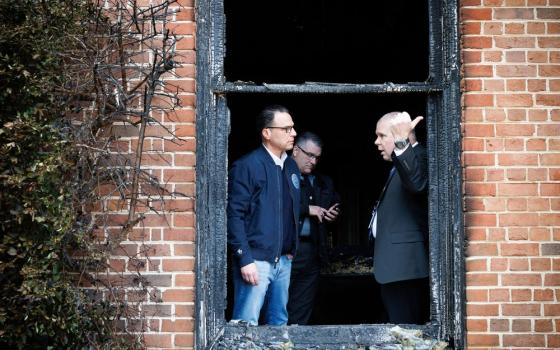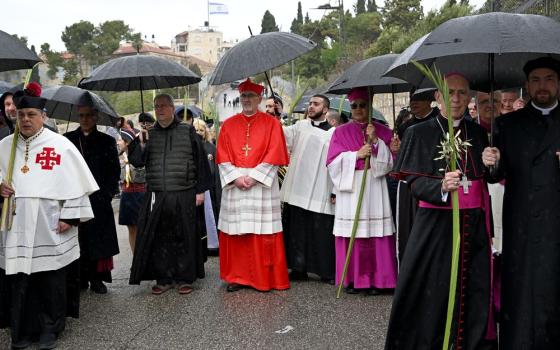
Pope Benedict XVI is making his first visit to Africa March 17-23, travelling to Cameroon and Angola. John Allen is in Africa covering the pope, and in this piece he previews the challenges awaiting Benedict on the first leg of the trip in Cameroon. Allen’s daily coverage will appear at NCRonline.
Yaoundè, Cameroon
Assuming Pope Benedict XVI has his eyes open when he touches down in Cameroon tomorrow afternoon, he’ll quickly discover that he picked a great place to dip his toes into Africa.
Guidebooks typically call Cameroon “Africa in miniature,” a reference to the sprawling ethnic, linguistic, geographical and religious diversity in this nation of 19 million, located on Africa’s west-central coast, which is roughly the size of California. (Sports fans probably know Cameroon best for its legendary soccer team, the “Indomitable Lions,” which has qualified for the World Cup more often than any other African squad; it made a storybook run into the quarter-finals in 1990, losing to England in penalty time.)
Seen through a Catholic lens, Cameroon captures the African story equally well, both its light and its shadows.
Over the years, Cameroon’s Catholic leadership has shown remarkable guts. The bishops have issued tough pastoral letters on corruption, tribalism and the need for greater democracy, staring a regime in the teeth that doesn’t exactly welcome criticism. Several still-unsolved murders of bishops, priests and nuns illustrate the price in blood that such witness sometimes demands. Yet the church here is also divided, observers say, including along ethnic and regional lines, and Catholics are not always immune to the tug of patronage and privilege. It’s a young, dynamic church, bursting at the seams with new members and new vocations, but it’s also afflicted by same ills as the broader society, including corruption and moral weakness. Given the intense religiosity of African societies, the church is also beset by competition on all sides, from traditional religions and Islam to new Pentecostal movements, African Initiated Churches, and even exotic secret societies.
Collectively, Cameroon’s challenges present Benedict XVI with a bracing introduction to the wider prospects for Catholicism on the continent – prospects which will be the subject of a special Synod for Africa in Rome in October, the working paper for which will be presented by the pope on Thursday in Yaoundè.
The Catholic Boom
Demographically, Cameroon mirrors Africa’s 20th century “Catholic boom”. According to a 2005 study by the Pew Forum, there are 147 million Catholics in Africa today, representing 17 percent of the continent’s population, up from less than 2 percent in 1900. In Cameroon, Catholics are more than 30 percent of the population, and the church runs the country’s largest network of schools and hospitals.
By all accounts, these Catholics aren’t just names in a parish registry; they’re remarkably active, especially by more lethargic Western standards.
“We have some of most committed Christians that you can think of, in terms of support for the church, and in terms of their religious and spiritual fervor,” said Fr. Patrick Lafon, former secretary general of the bishops’ conference in Cameroon, and today a doctoral candidate at the Catholic University of America.
“Our churches are jammed on Sundays,” Lafon said, and you don’t have to take his word for it. Tourist materials for Cameroon actually advise visitors, whether Catholic or not, to check out the always-packed Sunday Mass at Paroisse de N’Djong Catholic Church in Yaoundè, which stretches from 9:30 am all the way to noon. It’s billed as a “fabulous, energetic” expression of local culture.
Vocations are also surging. Consider that the United States, with a Catholic population of 70 million, has slightly more than 5,000 seminarians, creating a ratio of one future priest to every 13,900 Catholics. Cameroon, with a Catholic population of 5.7 million, has 1,230 seminarians, for a ratio of one future priest to every 4,600 Catholics. Pound for pound, in other words, Cameroon is churning out almost ten times as many candidates.
Such dynamism has given the church a serious punch in social and political affairs.
Independent journalist Charly Ndi Chia calls the Catholic church Cameroon’s “silent opposition, which isn’t always so silent” – meaning the only force capable of riding herd on the regime of President Paul Biya, a vintage African strongman who earned the dubious distinction of finishing on David Wallechinsky’s 2006 list of the “twenty worst living dictators.”
Cardinal Christian Tumi of Douala, now 78, is widely considered a national icon for his outspoken criticism of corruption and human rights violations, and his independence from the Biya government.
In what may be a perverse tribute to that role as a voice of conscience, several prominent Catholic leaders in Cameroon have lost their lives under suspicious circumstances in recent years, including:
•Fr. Joseph Mbassi, an editor-in-chief of L’Effort Camerounais, the country’s Catholic newspaper, murdered in October 1988, with his body mutilated;
•Fr. Bernabe Zambo, a pastor in the Bertoua archdiocese, poisoned in 1989;
•Fr. Anthony Fonteh, principal of Saint Augustine College in Nso, assassinated on campus in May 1990;
•Retired Archbishop Yves Plumey of Garoua, murdered in 1991;
•Sisters Germaine Marie and Marie Leonie of the Congregations of Daughters of Our Lady of Sacred Heart, killed in August 1992;
•Jesuit Fr. Englebert Mveng, a noted theologian, killed in 1995;
•German missionary Fr. Anton Probst, murdered in 2003.
In virtually every case, the motives for the killings still remain murky, but Lafon says Catholics are broadly convinced they were an effort “to intimidate the church, to keep it out of politics.” When Pope John Paul II visited Cameroon in 1995, he asked that these murders be solved; to date, local sources say, that request has largely gone unfulfilled.
Dizzying Challenges
Fourteen years after a pope last visited Cameroon, Catholicism here faces a dizzying set of challenges, both external and internal to the church.
Externally, the single greatest worry cited by most observers is the country’s “democratic deficit” under Biya, whose grip on power is virtually uncontested. While Cameroon has largely escaped the violence that has plagued other African societies in the almost five decades since it gained independence, this stability has come at a price.
“Through intrigues and manipulations, the opposition in Cameroon has been rendered helpless,” thundered a Feb. 20 editorial in The Post, one of the few media outlets independent of government control. “Those who could not beat Biya have finally joined him. Even the much-talked-of ‘international community’ is impotently watching Biya as he tramples on Cameroonians – the way the Greek gods watched from Mount Olympus as Achilles mowed down his enemies in the Trojan war.”
In that light, Lafon says the overt peacefulness of Cameroon is deceiving.
“It’s the peace of the graveyard,” he said. “People have just given up, and mind their own business.”
Corruption is an especially serious scourge. Misuse of public resources is so endemic that, according to Ndi Chia, a Cameroonian calling the police stands a good chance of being told that there’s no gas for the squad car. If they want help, they’ll need to bring the guy attacking them down to the station on their own.
In a June 16, 2008, address to Cameroon’s new ambassador to the Holy See, Benedict XVI brought up the “phenomenon of corruption,” and the pope is widely expected to address the topic again when he visits Biya on March 18 in his “Palace of Unity.” Ndi Chia, however, worries that the PR gains Biya will score by rubbing shoulders with the pope will outweigh any gentle prodding Benedict might offer.
To the extent that Cameroon’s stability remains fragile, perhaps the greatest threat is the long-running tension between the majority Francophones, who constitute 80 percent of the population, and the minority Anglophones. Modern Cameroon is the result of a fusion in 1961 between the former French colony of Camerun and the southern part of the British Cameroons, and the two communities have lived in an uneasy alliance ever since.
Lambert Mbom, a former Catholic seminarian currently residing in the United States, has published an open letter to Benedict XVI warning of a “potential phenomenal genocide” if the grievances of the Anglophones aren’t resolved. While few observers would go quite that far, most agree that it’s Cameroon’s most serious open wound.
In a 2006 speech to Cameroon’s bishops, Benedict XVI praised the fact that the conference brings together both Francophone and Anglophone prelates, calling it “an eloquent sign of that unity which you experience.” In reality, however, observers say these regional fissures sometimes run through the church. After the murder of a priest in the Anglophone region in 2006, Catholic members of the Southern Cameroons National Council, a separatist movement, published an open letter which pointedly asked when their fellow Catholics in Francophone areas will “read the handwriting on the wall and defend the truth.”
Benedict ticked off a whole series of other social concerns when he met Cameroon’s new ambassador to the Holy See last June, all of which are likely to surface again during his three days in the country: economic development, including encouragement for “micro-projects”; poverty and debt relief; the arms trade; human trafficking; and the impact of tropical diseases and HIV/AIDS. (Some 39,000 Cameroonians died of AIDS in 2007, according to U.N. statistics, and 5.1 percent of the adult population is infected with HIV.)
Though the pope will not formally meet Catholics involved in promoting women’s rights until he reaches Angola, it’s an issue he may also want to surface while in Cameroon. Just last week, a U.N.-sponsored conference at the Yaoundè Hilton revealed that 51 percent of women in Cameroon have been victims of violence, including 11 percent who suffered violence while pregnant. Officials said that 21 percent of women in Cameroon marry before they’re fifteen, and 24 percent experience genital mutilation. A U.N. spokesperson called all this “a serious obstacle to development.”
Cameroon has also been hit hard by rising global food prices since 2004, generating a spike in hunger, especially in rural areas. The country was rocked by a series of “food riots” in 2008, and most observers say the situation remains volatile.
Internal questions
As if that weren’t enough, a host of internal questions hovering over Catholicism in Cameroon are also competing for Benedict’s attention.
For one thing, Lafon, the former secretary general of the bishops’ conference, says the church’s witness in defense of human rights and democracy is hobbled by the fact that the bishops “don’t speak with one voice.”
“Some feel they must support the president at all costs, especially those from his tribal area,” he said.
Here’s a recent example of what cynics might construe as currying favor: One month ago, bishops and clergy from Biya’s home region dedicated a new “presidential chapel” nestled ten yards from Biya’s private residence. The 200-seat church is a replica of the cathedral in Yaoundé. Some observers found the exercise particularly craven, given that the ceremony was significantly delayed awaiting the arrival of Biya and his wife – who, in the end, never showed up.
In miniature, the delicate balance Cameroon’s bishops have to strike vis-à-vis Biya may capture the broader challenge facing African Catholicism: Staying close enough to dysfunctional regimes to exercise influence, but keeping enough distance to remain objective.
Beyond church/state matters, Catholicism also faces stiff competition in Cameroon’s religious marketplace.
One major player is Pentecostalism. The Pew Forum estimates that Pentecostals today account for 12 percent of Africa’s total population, and much of their gains have come at the expense of the Catholic church. During last fall’s Synod on the Bible, Cardinal Polycarp Pengo of Tanzania described an “exodus” of Catholics to Pentecostal movements all across the continent. In his 2006 address to bishops from Cameroon, Benedict XVI likewise lamented an “invasion of sects,” widely a Vatican code word for mushrooming forms of Evangelical and Pentecostal Christianity.
Cameroon is also home to a surprisingly strong undercurrent of quasi-religious and mystical societies, imported from Europe during the colonial era, which have since become powerful gateways to political and commercial success.
Biya himself is widely rumored to have links to the Rosicrucians, a Masonic offshoot popular among the erstwhile French ruling class. During the 1994 Synod for Africa, Bishop Jean-Baptiste Ama of Cameroon said that much of the country’s “intelligentsia” are Rosicrucians; in 2005, Archbishop Victor Tonye Bakot of Yaoundè warned of efforts by Rosicrucians to organize in the capital, and said emphatically “we denounce and energetically condemn their teaching.”
Some forty percent of Cameroonians are adherents of traditional religions, and even Catholics sometimes feel the lure of ancient beliefs and practices. Lafon said many Catholics will show up for Mass on Sunday, but if there’s sickness or death in the family, they’ll also consult their tribal medicine man to find out who placed the curse and what they need to do to lift it. He called that evidence of “insufficient catechesis and insufficient inculturation.”
One bright spot may be Catholic/Muslim relations in Cameroon, which by most accounts are remarkably harmonious. In part, observers say, that’s because the Muslim minority (roughly 20 percent of the population) is concentrated in the north and largely concerned with defending their ethnic and communal interests, as opposed to proselytizing campaigns.
Another serious internal quandary concerns clerical discipline. Though observers say most priests do heroic work against long odds, the country has witnessed a series of scandals which, collectively, have hurt the church’s moral authority.
A blistering editorial in advance of the pope’s visit by Cameroonian human rights activist Emanuel Neba Fuh, published March 9 by The Post, lays it out: “Today, we find a Cameroonian society made of men who have come into the sacred corps of the priesthood with no intention whatsoever to imitate Christ, or to strive daily to live by his teachings and those of the church,” Neba Fuh wrote.
“What lessons can an already morally impoverished society learn from a bishop or priest who fathers children haphazardly in his community?” Neba Fuh asked. “Or who sponsors a girlfriend’s trip abroad so she can bear him kids, and when he takes his vacation or study leave, he is welcomed abroad by his wife and children? Or from a principal of a school, a priest, who embezzles money through fake bills and accounting? Or from priests who have become predators to vulnerable children, or who indulge in homosexual acts?”
Benedict XVI obliquely alluded to such episodes in his 2006 address to the country’s bishops, calling on them to form priests in “the need for a chaste life lived in celibacy, in conformity with the law of the church,” and in “a healthy relationship with material goods.”
To be sure, such problems are hardly confined to Cameroon, or to Africa, and the recent sexual abuse crisis in the United States and elsewhere provides painful proof of the point. Nonetheless, Neba Fuh’s article offers a reminder that the pope’s 2006 challenge remains a work in progress here too.
Over the moon
Whatever the long-term impact of Benedict’s visit, it seems a safe bet that it will play to large and enthusiastic crowds.
Lafon said Catholics are “over the moon” that a pope has again chosen Cameroon to launch a message to Africa. (When John Paul II came in 1995, he used the occasion to present “Ecclesia in Africa,” his document summing up the 1994 Synod for Africa. With Benedict’s visit, Cameroon becomes just the third African nation to have hosted three papal trips.)
“For sure, people will stream to Yaoundè, or they will be glued to their TV sets,” Ndi Chia said. “They’ll buy all kinds of gadgets with the pope’s image, and so on. … Catholics in Cameroon are fanatical about the trip.”
In a country sometimes defined by “the peace of the graveyard,” in Lafon’s memorable phrase, perhaps such euphoria – however transitory it may prove – will be enough to judge Benedict’s African debut a success.
John L. Allen Jr. NCR Senior Correspondent. His e-mail address is jallen@ncronline.org. He is traveling with the pope in Africa.
Reports he has already filed include:
- Accent on 'peace, fraternity' sets tone for Angola
- Benedict in Cameroon a tale of two trips
- Pope to Muslims: 'Religion rejects all violence'
- Pope demands halt to sexual, financial scandals
- Pope's condom message resonates with many
- Pope addresses corruption, conflict in Africa
- 'Africa in miniature,' warts and all, awaits Benedict
- Five reasons the papal trip to Africa is important
- Cameroon journalist warns of 'cheap political points' from pope’s visit
- Benedict needs to show that he 'gets' Africa
~~~~~~~~~~~~~~~~~~~~~~~~~~~~~~~~~~~~~~~~~~~~~~~~~~~~~~




